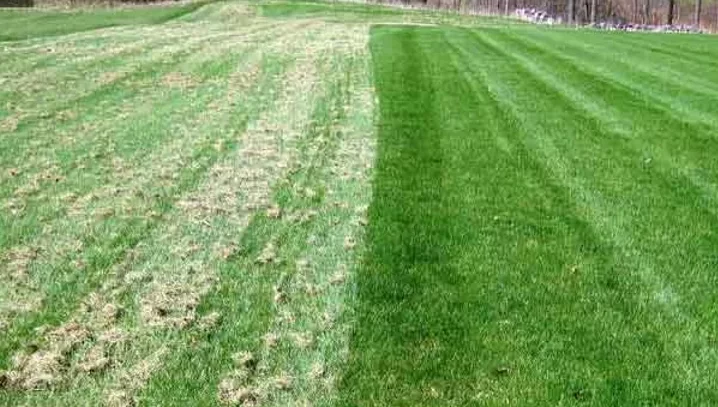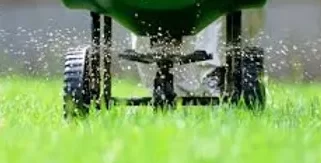AFTERCARE
Lawn Aeration:
Your lawn was aerated using a mechanical process that extracts cores of soil, thatch and grass from the surface of the lawn. Your after care instructions are to simply leave the plugs (cores of soil) where they are and to mow as usual. Don’t you love a service that can have such a positive impact on the health of your lawn but requires no extra work from you?
Benefits of Core Aeration:
- Increases moisture penetration
- Enhances oxygen exchange (important for healthy roots)
- Reduces soil compaction (especially soils high in clay)
- Supports penetration of fertilizers and other lawn products
- Assists rate of thatch decomposition
- Aids in root development

Golf courses and athletic field managers have realized the benefits of aeration on their turf fields for years and frequently aerate their grounds multiple times throughout the year.
How Long Will the Plugs Stay on the Lawn? Depending on your grass type and height, you may see relatively large amounts of plugs lying on top of the lawn. This is normal and the plugs should be left alone. They will begin to breakdown and filter back into the lawn, aiding the thatch decomposition process. Through rainfall and mowing, these cores will breakdown over a two week period. Irrigation will speed up this process.
We recommend lawn aeration twice annually to ensure the healthiest lawn possible.
Lawn Dethatching:
After your lawn has been dethatched your lawn may now look like it is unhealthy or bare but this is perfectly normal as it will benefit in the long run. Now is the perfect time to aerate, overseed and fertilize your lawn to bring it back. Dethatching may not remove all of the moss, at this point it would be good to apply moss killer to kill back anything remaining.

Overseeding & Watering:
Successful seed germination depends on special care the first month. To assure proper germination, water regularly to keep the lawn damp. Keeping the yard moist will maximize results. You may walk on the lawn when watering, but keep traffic to a minimum. It is very important to keep all animals away from the planted area until established. Seed best germinates with day time temperatures between 55f and 80f.
Watering Schedule: Temps Below 70 Deg.
Day Frequency Amount
1-15 2 Times/Day 20 Minutes
15-30 1 Time/Day 25 Minutes
30-44 4 Times/Week 30 Minutes
>44 2 Times/Week 35 Minutes
Watering Schedule: Temps Over 70 Deg.
Day Frequency Amount
1-15 3 Times/Day 20 Minutes
15-30 2 Times/Day 25 Minutes
30-44 4 Times/Week 35 Minutes
>44 2 Times/Week 35 Minutes

This is an average watering schedule based on a typical lawn. If it rains enough to keep the lawn damp then watering can be skipped that day if sufficient.
If you have an irrigation system, try and set it for the most cycles possible (say 6 to 8 waterings per day) at about 3-5 minutes per cycle during the germination period.
Fertilization:
Our fertilizer will feed the lawn for up to 12 weeks after application, please do not add any additional fertilizer in this time unless instructed. Our fertilizer should be avoided until fully dissolved as it is not pet/children safe. We do offer an organic fertilizer that is pet/children safe for an upcharge.
Use of “weed and feed” fertilizer. This type of fertilizer can be hard on a new lawn. If broadleaf weeds are a concern we recommend treating the individual weeds with a product like “weed-b-gone”. If you do use “weed and feed” we recommend waiting until the lawn is at least three months old before using.
Mowing:
Mowing can begin once the new lawn is 3″ tall in most areas. Mowing stimulates growth and increases thickness. Set the mower high at first, and then gradually lower. Try to cut no more than 1/3 of the grass at a time.
One general rule for mowing is that the shorter you want to mow the more often you need to mow to maintain healthy grass. Try to mow your lawn in different directions each time, as to not create ruts and grow patterns.
Cutting grass too short can stress the plant out causing it to let weeds and other undesirables creep in.
Lime:
Lime should be avoided by pets until it is dissolved, this can happen quickly with a good watering or rainfall. The lime will work into the soil with moisture to raise the pH, this can be a slow process and more than one application may be needed.